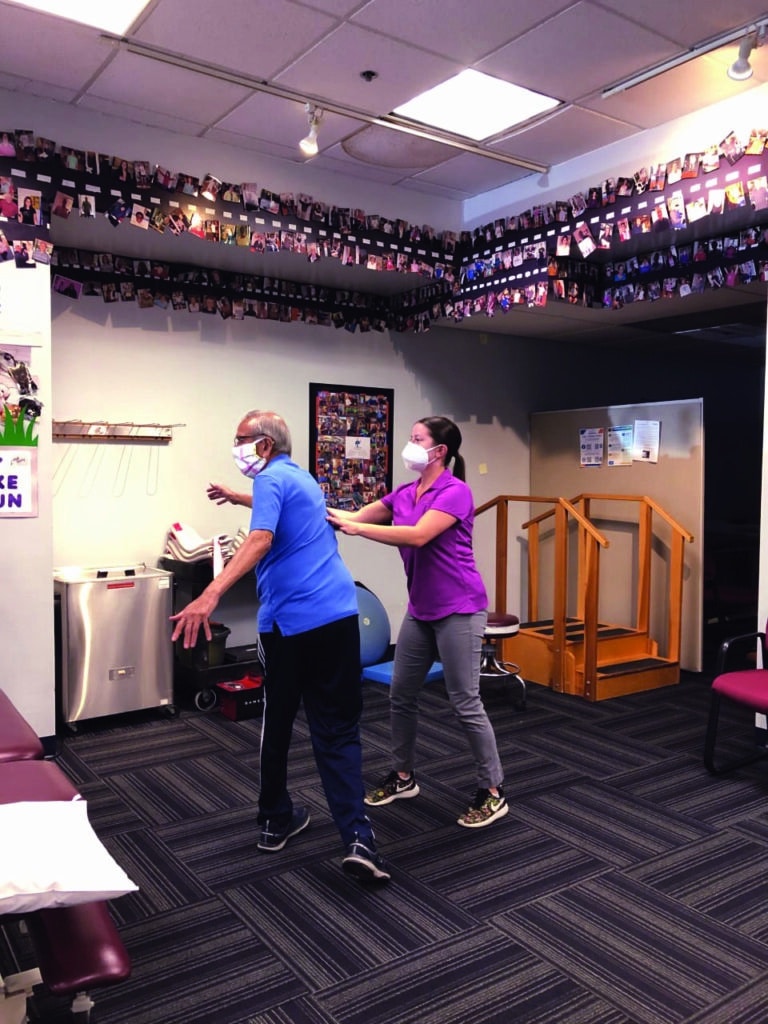How to optimize your physical therapy treatment sessions and use exercise as a form of medication to overcome symptoms of Parkinson’s disease
By Alexandra Taratuski, PT, DPT
According to the Parkinson’s Foundation, by the end of this year, there will be nearly one million people in the United States living with Parkinson’s disease (PD).1 The major symptoms of this neurodegenerative disease include tremors, rigidity, and bradykinesia, which simply means a slowness in movements.1 Many of these symptoms impact a patient’s ability to perform activities of daily life safely and lead to decreased confidence in their mobility.
Since there is no cure for PD, many patients begin on a pharmacological regimen to address symptoms. However, many of these medications can lead to less than favorable side effects and will lose effectiveness as the disease progresses.2 Another form of treatment has been shown to interfere with cell death, stimulate growth of new neurons, and provide dopamine cells with protection from neural destruction.3 That treatment is exercise. Exercise and physical therapy are underutilized as forms of treatment even though an emphasis on this form of treatment would help to reduce healthcare spending for PD in the United States.
Where there exists a gait dysfunction or movement disorder, there is a physical therapist waiting in the wings to be called to the stage. As physical therapists, we are taught to treat impairments to restore prior levels of functioning due to injuries. However, since PD is progressive in nature and the impairments are often global, it is hard for physical therapists to prioritize their treatment plans. It is our duty as physical therapists to apply the best practices to ensure the best outcomes for our patients. As an LSVT Certified Clinician, I have had the pleasure of treating many patients with PD over the last 4 years. I will say that no two patients with PD will present the same, but I have had consistent success across a variety of impairments by implementing the following philosophies into my treatment plans.

All About Amplitude
Amplitude-driven training of movement is one of the core concentrations behind the LSVT BIG protocols. The amplitude with which a patient performs tasks can be observed in their reduced arm swing with ambulation, foot clearance during gait, ability to perform sit-to-stand transfers without the appropriate momentum, or simply standing posture. Amplitude can be difficult to treat in patients with PD as they perceive their movements as “normal” when, in fact, their movements are much slower and smaller, or hypokinetic. This is because dopamine loss in the brain with PD causes a “faulty processing of kinesthetic feedback, motor output, and context feedback within the basal ganglia.”3
Because of this, the patient must be educated as to where their movements need to be larger and more deliberate for them to feel the effort required to achieve the appropriate amplitude with mobility. In a sense, they need to retrain their motor feedback system. In the physical therapy clinic, patients should be provided feedback from the minute they walk through the door, with every exercise or activity they perform—and even as they walk to their car to leave, as to the appropriate level of amplitude (or bigger!) to influence changes in their everyday life with movement. This is also where the Lee Silverman Voice Treatment (LSVT) LOUD and BIG come into play. From a physical therapy and BIG standpoint, patients are given specific exercises that focus on breaking through hypokinesia.
Repetition, Repetition, Repetition
In order to see carryover of increased amplitude with movement, it is important to pair this with repetition. It is this key factor that can drive neuroplasticity and physical changes in the brain. This means that patients will need to perform exercises with great frequency initially to create their new baseline. Since LSVT exercises are task specific, focusing on amplitude of movement, and performed at an increased frequency than traditional physical therapy, it can result in “longer retention and produce task-specific changes in the brain.”1 Of course, we need to justify to insurance companies that we can show improvement by utilizing increased frequency of physical therapy.
Performing timed tasks periodically can track the level of carryover that the patient is seeing in the home and in the community. I have timed patients performing five sit-to-stand transfers, buttoning a shirt, zipping a jacket, taking off shoes and socks, and even getting money out of a wallet. These tasks all take increased amplitude of motion to be able to override bradykinesia. If practice truly makes perfect, then repeating these activities at the appropriate amplitude ad nauseum will lead to improvement in the patient’s mobility when he or she leaves your clinic, and not just while in physical therapy.
Dynamic Balance
I often hear from patients that they do not have confidence in their balance with walking across grass or uneven surfaces, turning to say hello to someone while walking in a store, or walking across their bedroom in the middle of the night to get to the bathroom. These are all examples of how dynamic balance training can help to improve confidence and steadiness on their feet. Traditionally, balance is practiced in a very static way with simple standing exercises. For some patients with later-stage PD, this may be a highly effective way to improve balance. However, a patient who is newly diagnosed may find these exercises too easy and not as functionally related to their specific impairments.
Performing a Dynamic Gait Index (DGI) with a patient will help to illustrate what activities may cause imbalance. Grab your gait belts because to effectively improve balance with activities you should be practicing those very scenarios that cause the most unsteadiness to reduce the patient’s risk for falls. For example, you can recreate an unsteady surface for walking with foam surfaces or by placing ankle weights along the ground with a yoga mat lying over them. I always like to end a physical therapy session for these patients with an “obstacle course” that makes them traverse foam pads, weave through cones, perform head movements with ambulation, and even perform coordinated foot patterns through agility ladders.
Dual-Task Activities
Progression of PD can also bring about cognitive changes including dementia.4 Add impaired planning and attention to the list of symptoms of someone who already has a movement dysfunction and you have a recipe for falling. Enter dual-task training! It is becoming more apparent that the increased postural and gait instability seen in patients with impaired executive function is due to “impaired attentional resource allocation.”5
The easiest way to test for impaired abilities with dual-task activities is to have your patient perform a Timed Up and Go (TUG) while counting backward from 100, by threes. If gait significantly slows for the patient to perform the cognitive task, this could indicate a decline in executive function. Left unaddressed in physical therapy and without cognitive therapy, patients will be left with a greater fall risk. The slowing of gait while performing a cognitive task illustrates how two separate tasks will compete for cortical resources and significantly impact motor-gait control.5
Adding a cognitive layer to any challenging physical task in physical therapy can help lead to carryover with activities at home that may require divided attention, like carrying a laundry basket or talking on the phone while walking up the stairs. I try to challenge my patients by having them name different fruits or colors while weaving in and out of cones or reading a list of words while standing on an unsteady surface.
Boxing is another example of how dual tasking can be incorporated with exercise by providing verbal cues such as “right” or “left” to force the patient to switch attention between the visual and auditory cues.6 The possibilities are endless, but the most effective way to train patients is to closely mimic the exact functional tasks at home that they struggle with and to engage their family members to provide examples that the patient has difficulty with but may not see themselves.
Freezing Management
By freezing of gait, I mean a “brief, episodic absence or marked reduction of forward progression of the feet despite the intention to walk.”6 This is a unique impairment that affects many patients with PD and increases risk for falls. It is often one of the more difficult impairments to overcome with exercise alone and responds well to pharmacological intervention. However, patients often experience “on” and “off” times with their medications, which can present challenges with scheduling physical therapy.
Some patients have such severe freezing during “off” times of medications, they may struggle to complete the simplest of ambulatory exercises. However, it is these visits where the impairment is not masked by medication, that you should take advantage of addressing the patient’s challenges with freezing. Freezing of gait can be triggered while walking through doorways or when a patient is forced to switch attention between tasks, similarly, seen with imbalance performing dual tasks.
There is evidence that suggests integration of cognitive and motor rehabilitation is important for patients with PD who struggle with freezing.6 As with dual task training, then, adding cognitive tasks with ambulation will help to also reduce freezing of gait. I have also had success with interrupting the forward momentum patients often feel with freezing, by bringing attention to their footing and center of gravity in these moments.
By taking a side step or simply shifting their center of gravity into their heels, it provides a small “reset” of the motor pathway and the patient is often able to begin ambulating again. There are limitations with this method, though, because if the patient has already begun to see cognitive decline, it is often more difficult to influence carryover of this behavior when they leave the clinic without family support.
Conclusion
As more people across the country are diagnosed with PD we, as physical therapists, have a responsibility to provide the best care possible. The prevalence of PD is predicted to quadruple by 2040 and exceed 50 billion dollars of health-related expenses in the United States.3 By providing physical therapy and exercise as an effective type of intervention for symptoms related to PD, we can help to drive down spending on pricey surgical procedures and medications. It will be up to us to not only treat the symptoms but to create treatment plans that will drive neuroprotection and act as another form of medication. Exercise truly is medicine! RM
Alexandra Taratuski, PT, DPT, received her Doctorate of Physical Therapy from Widener University in 2015. She also attended Widener for her undergraduate degree in Biology with a minor in Psychology. Taratuski has been an LSVT BIG Certified Clinician for 3 years as well as certified by the American Institute of Balance to treat vestibular disorders and post-concussion syndrome. Taratuski is currently the Clinic Director at the Physical Therapy and Wellness Institute in Montgomeryville, Pa, where she treats a variety of orthopedic injuries as well as gait and balance dysfunctions. For more information, contact [email protected].
References
- Spears C. Movement Symptoms. Parkinson’s Foundation, 2020. www.parkinson.org/Understanding-Parkinsons/Movement-Symptoms
- Palasz E, Niewiadomski W, Gasiorowska A, Mietelska-Porowska A, Niewiadomska G. Neuroplasticity and neuroprotective effect of treadmill training in the chronic mouse model of Parkinson’s disease. Neural Plast. 2019:1-14. doi:10.1155/2019/8215017
- Farley BG, et al. Intensive amplitude-specific therapeutic approaches for Parkinson’s disease. Top Geriatr Rehabil. 24(2);2008:99–114. doi:10.1097/01.tgr.0000318898.87690.0d.
- Spears C. Non-Movement Symptoms. Parkinson’s Foundation, 2020. www.parkinson.org/Understanding-Parkinsons/Non-Movement-Symptoms
- Montero-Odasso M, Speechley M. Falls in cognitively impaired older adults: implications for risk assessment and prevention. J Am Geriatr Soc. 66(2);2018:367-375. doi:10.1111/jgs.15219
- Peterson DS, King LA, Cohen RG, Horak FB. Cognitive contributions to freezing of gait in Parkinson disease: implications for physical rehabilitation. Phys Ther. 96(5);2016:659–670. doi:10.2522/ptj.20140603



